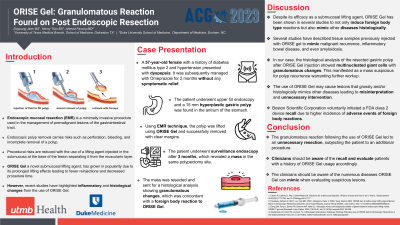Monday Poster Session
Category: General Endoscopy
P1996 - ORISE Gel: Granulomatous Reaction Found on Post Endoscopic Resection
Monday, October 23, 2023
10:30 AM - 4:15 PM PT
Location: Exhibit Hall

Has Audio

Dayoung K. Jeon, BS
University of Texas Medical Branch at Galveston
League City, TX
Presenting Author(s)
Dayoung Jeon, BS, Henry Tran, BS, Ahmad Farooq, MD
University of Texas Medical Branch at Galveston, Houston, TX
Introduction: Endoscopic mucosal resection (EMR) and endoscopic submucosal dissection (ESD) are minimally invasive procedures for managing premalignant gastrointestinal tract (GI) lesions. Endoscopic polyp removal carries risks such as perforation, bleeding, and incomplete removal of a polyp. Procedural risks are reduced by using a lifting agent injected in the submucosa to separate the lesion from the muscularis layer. ORISE Gel (Boston Scientific, Marlborough, Mass, USA), a novel lifting agent, offers prolonged lifting effects, reducing injections and procedure time. However, recent studies have highlighted inflammatory and histological changes with its use. We present a case of a 57-year-old female who developed a foreign body-type giant cell reaction at the polypectomy site 3 months after undergoing gastric polyp EMR with ORISE Gel.
Case Description/Methods: A 57-year-old female with diabetes mellitus type 2 and hypertension presented with dyspepsia. Omeprazole 40 mg QD was prescribed for 2 months but provided no relief. Upon endoscopy, a 15 mm gastric polyp was found in the antrum, which was lifted and successfully removed with clear margins by EMR technique with ORISE Gel. Histologic analysis revealed a hyperplastic polyp with intestinal metaplasia. Three months later, surveillance endoscopy revealed a mass at the same site, which was resected and subjected to histological analysis. The examination showed granulomatous changes consistent with a foreign body reaction to ORISE Gel, but no evidence of intestinal metaplasia.
Discussion: Despite its efficacy as a lifting agent, ORISE Gel has been found to induce foreign body type reactions and histological changes mimicking other diseases. Previous studies have reports ORISE Gel-injected tissue samples mimicking malignant recurrence, inflammatory bowel disease, and amyloidosis. In our case, histological analysis showed multinucleated giant cells with granulomatous changes, resembling polyp recurrence. This highlights the potential for ORISE Gel to mimic various diseases, leading to misinterpretation and unnecessary interventions. Therefore, clinicians should be aware of these possibilities when evaluating suspicious lesions at previously ORISE-injected sites and document the use of ORISE Gel accordingly.
Disclosures:
Dayoung Jeon, BS, Henry Tran, BS, Ahmad Farooq, MD. P1996 - ORISE Gel: Granulomatous Reaction Found on Post Endoscopic Resection, ACG 2023 Annual Scientific Meeting Abstracts. Vancouver, BC, Canada: American College of Gastroenterology.
University of Texas Medical Branch at Galveston, Houston, TX
Introduction: Endoscopic mucosal resection (EMR) and endoscopic submucosal dissection (ESD) are minimally invasive procedures for managing premalignant gastrointestinal tract (GI) lesions. Endoscopic polyp removal carries risks such as perforation, bleeding, and incomplete removal of a polyp. Procedural risks are reduced by using a lifting agent injected in the submucosa to separate the lesion from the muscularis layer. ORISE Gel (Boston Scientific, Marlborough, Mass, USA), a novel lifting agent, offers prolonged lifting effects, reducing injections and procedure time. However, recent studies have highlighted inflammatory and histological changes with its use. We present a case of a 57-year-old female who developed a foreign body-type giant cell reaction at the polypectomy site 3 months after undergoing gastric polyp EMR with ORISE Gel.
Case Description/Methods: A 57-year-old female with diabetes mellitus type 2 and hypertension presented with dyspepsia. Omeprazole 40 mg QD was prescribed for 2 months but provided no relief. Upon endoscopy, a 15 mm gastric polyp was found in the antrum, which was lifted and successfully removed with clear margins by EMR technique with ORISE Gel. Histologic analysis revealed a hyperplastic polyp with intestinal metaplasia. Three months later, surveillance endoscopy revealed a mass at the same site, which was resected and subjected to histological analysis. The examination showed granulomatous changes consistent with a foreign body reaction to ORISE Gel, but no evidence of intestinal metaplasia.
Discussion: Despite its efficacy as a lifting agent, ORISE Gel has been found to induce foreign body type reactions and histological changes mimicking other diseases. Previous studies have reports ORISE Gel-injected tissue samples mimicking malignant recurrence, inflammatory bowel disease, and amyloidosis. In our case, histological analysis showed multinucleated giant cells with granulomatous changes, resembling polyp recurrence. This highlights the potential for ORISE Gel to mimic various diseases, leading to misinterpretation and unnecessary interventions. Therefore, clinicians should be aware of these possibilities when evaluating suspicious lesions at previously ORISE-injected sites and document the use of ORISE Gel accordingly.
Disclosures:
Dayoung Jeon indicated no relevant financial relationships.
Henry Tran indicated no relevant financial relationships.
Ahmad Farooq indicated no relevant financial relationships.
Dayoung Jeon, BS, Henry Tran, BS, Ahmad Farooq, MD. P1996 - ORISE Gel: Granulomatous Reaction Found on Post Endoscopic Resection, ACG 2023 Annual Scientific Meeting Abstracts. Vancouver, BC, Canada: American College of Gastroenterology.
